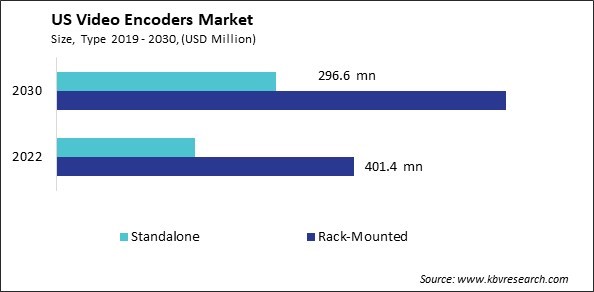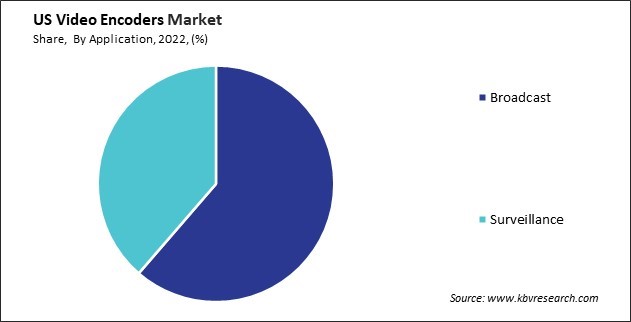The USA Video Encoders Market size is expected to reach $903.2 million by 2030, rising at a market growth of 5.6% CAGR during the forecast period. In the year 2022, the market attained a volume of 964.4 thousand units, experiencing a growth of 5.4% (2019-2022).
The video encoder market in the US has witnessed significant expansion in recent years, primarily driven by the growing demand for video content across various industries. Factors like the proliferation of online streaming services, the rise of video-on-demand platforms, and the expansion of IP-based video surveillance systems have contributed to the expansion of the video encoder market.

Technological advancements, such as the adoption of HEVC (High-Efficiency Video Coding) and AV1 (AOMedia Video 1) codecs, have also fueled market growth. Furthermore, the growing trend of remote work, distance learning, telemedicine, and live video broadcasting has increased the demand for video encoding solutions that efficiently handle real-time video transmission and processing.
For example, the National Center for Education Statistics of the United States reports that 61 percent of all undergraduate students, or 9.4 million, were enrolled in at least one distance education course in the fall of 2021. Distance education courses were exclusively pursued by 28% or 4.4 million students of the total undergraduate population.
Moreover, a new Pew Research Center survey published on March 30, 2023, revealed that approximately 35% of workers who have remotely performable jobs do so in the United States, even about three years after the COVID-19 pandemic disrupted workplaces. This represents an increase from 7% prior to the onset of the pandemic. Similarly, as reported in the third edition of McKinsey's American Opportunity Survey, 87 percent of Americans accept the opportunity to work flexibly.
Live streaming and broadcasting in America have experienced a seismic shift, transforming the way individuals consume media and businesses engage with their audiences. Platforms like Twitch, YouTube Live, and Facebook Live have become cultural hubs, hosting an array of content, from gaming streams and concerts to educational seminars and news broadcasts.
The emergence of content creators and influencers has further propelled the live-streaming phenomenon. Individuals and brands harness live video's power to build communities, share expertise, and establish authentic connections with their audiences. Real-time engagement, immediate feedback, and the ability to interact directly with viewers have become invaluable tools for building rapport and driving engagement.
News broadcasting has also transformed significantly, with platforms like CNN, MSNBC, and ABC News utilizing live streaming to deliver breaking news, political events, and commentary, allowing audiences to access news coverage in real-time from their devices. Additionally, sports leagues like the NFL, NBA, and MLB have embraced live streaming to broadcast games, providing fans alternative ways to enjoy sporting events and engage with their favorite teams.
Moreover, the entertainment industry has witnessed significant events being live-streamed, such as music festivals like Coachella and Lollapalooza, award shows like the Oscars, and even charity events like the Live Aid concerts. These live-streamed events cater to audiences globally, offering a front-row experience regardless of geographical location.
Thus, the exponential growth of live streaming and broadcasting in America has created an insatiable demand for video encoders capable of handling the complexities of live video transmission. Encoders' pivotal role in ensuring high-quality, real-time delivery of content across diverse platforms and applications underscores their significance in the expanding landscape of live content consumption.
In recent years, the United States has witnessed an unprecedented surge in online video consumption, reshaping the way individuals interact with entertainment, information, and social media. User-generated content has exploded in popularity across platforms like YouTube, TikTok, and Instagram. This surge in content creation has diversified the types of videos available and significantly contributed to the overall increase in online video consumption. From these educational tutorials to comedy sketches, these platforms have become hubs for creators to share their content with massive global audiences, fostering a culture of constant engagement and viewership.
The increasing use of various social media platforms is the primary factor propelling the consumption of online videos. According to an article by the World Economic Forum published in 2022, YouTube was the most popular site in the US, with most US teens between the ages of 13-17 regularly visiting the website or app. After YouTube, TikTok was the most significantly used platform, followed by Instagram and Snapchat.
The proliferation of the Internet of Things (IoT) and mobile devices in America has reshaped how individuals interact with technology, supporting the development of unparalleled connectivity and convenience. Mobile devices, primarily smartphones and tablets, have become ubiquitous, serving as multifunctional tools integral to everyday life. The widespread adoption of these devices has been fueled by advancements in technology, improved affordability, and an ever-expanding array of applications and services.
According to The Mobile Economy North America 2022 report by GSMA, smartphone adoption and subscriber penetration in the US are expected to reach 85% and 86% by 2025, respectively. This report also stated that existing 5G users are becoming more interested in adding content and services (such as video streaming, gaming, live sports, music, and cloud storage) to their 5G plans as consumers intend to upgrade to 5G infrastructures, including smartphones, increases nationwide. Therefore, as the landscape of mobile and IoT devices continues to evolve, incorporating more sophisticated features and expanding connectivity, the demand for efficient video encoders that can handle the complexities of diverse video streams is expected to persist.

The video encoders market in the US is highly competitive, with key players continuously innovating and developing new encoding technologies to meet the evolving demands of consumers and businesses alike. US companies and global players are investing in research and development to improve encoding efficiency, reduce latency, and enhance overall video quality.
The adoption of High-Efficiency Video Coding (HEVC) continues to grow among streaming platforms and broadcasters in the US. For example, Fox Sports utilized HEVC encoding to deliver high-quality video content during live sports broadcasts, allowing for improved compression efficiency and bandwidth utilization while maintaining broadcast standards.
Furthermore, Wowza introduced real-time monitoring and analytics capabilities within their encoding solutions, allowing users to track viewer metrics and analyze streaming performance instantaneously.
CISCO, Harmonic, and Motorola Solutions are the key players operating in the video encoders market in the US, each operating at a distinct stage throughout the value chain.
In the US, there is a growing shift towards the adoption of advanced video compression codecs like HEVC (H.265) and AV1. To accommodate this increasing demand, Z3 Technology announced the availability of two new high-quality, low-bandwidth H.265 video encoder solutions in November 2022. In response to this rising demand, Z3 Technology introduced two new low-bandwidth, high-quality H.265 video encoder solutions in November 2022.
By Type
By Application
By Number of Channel
Our team of dedicated experts can provide you with attractive expansion opportunities for your business.

